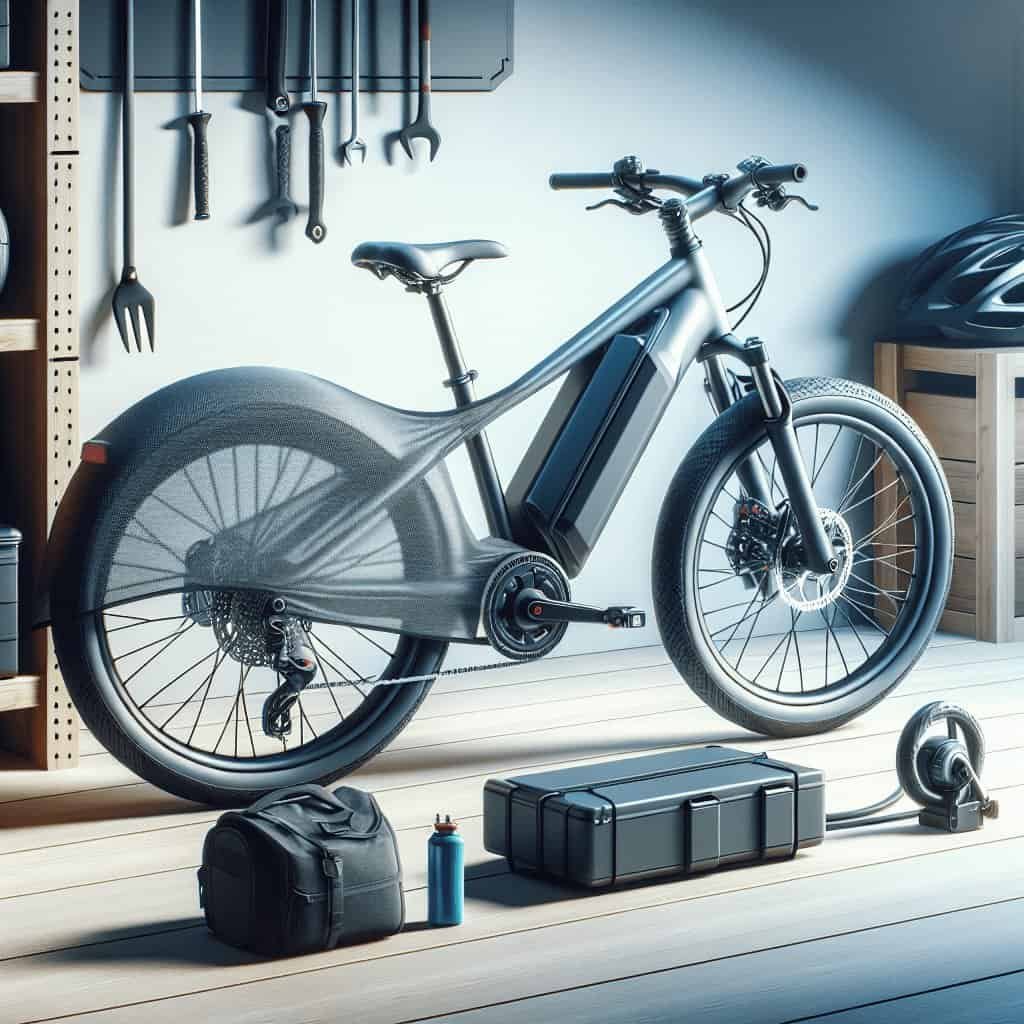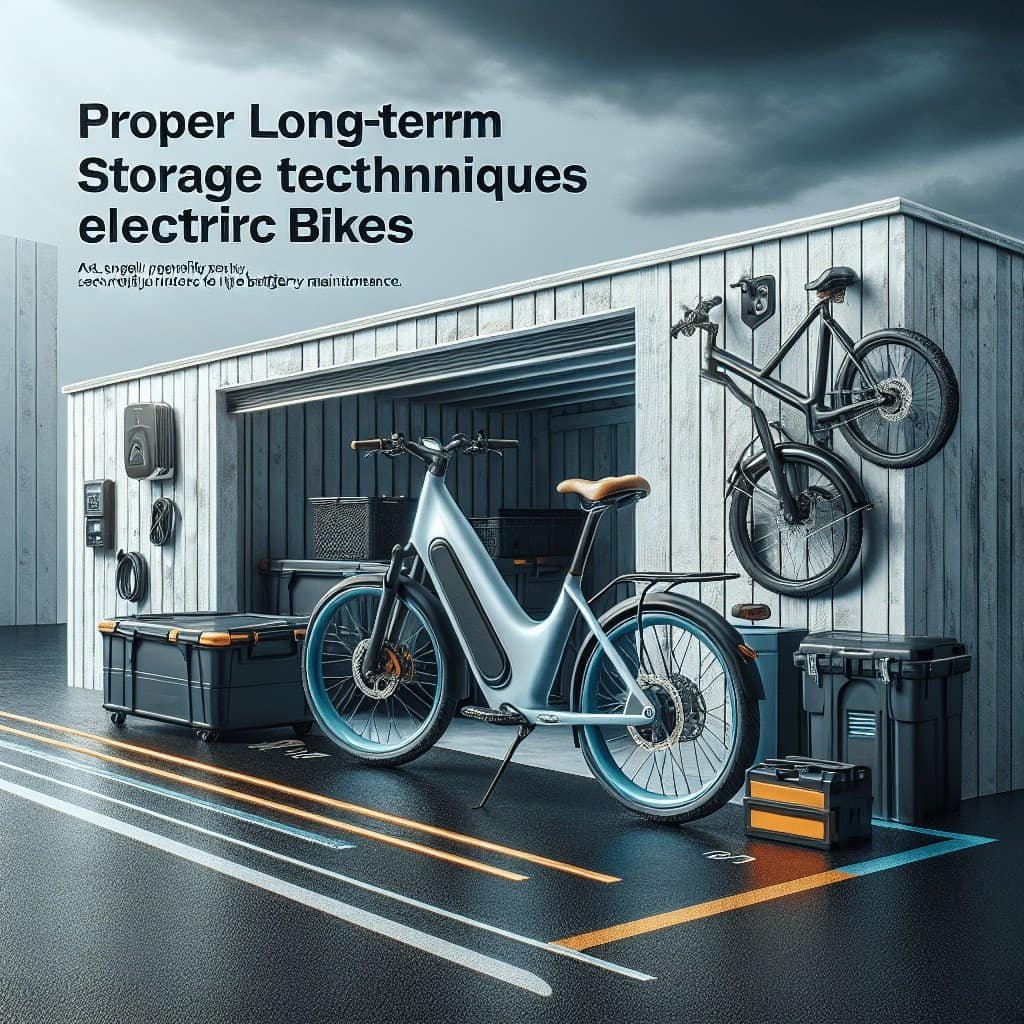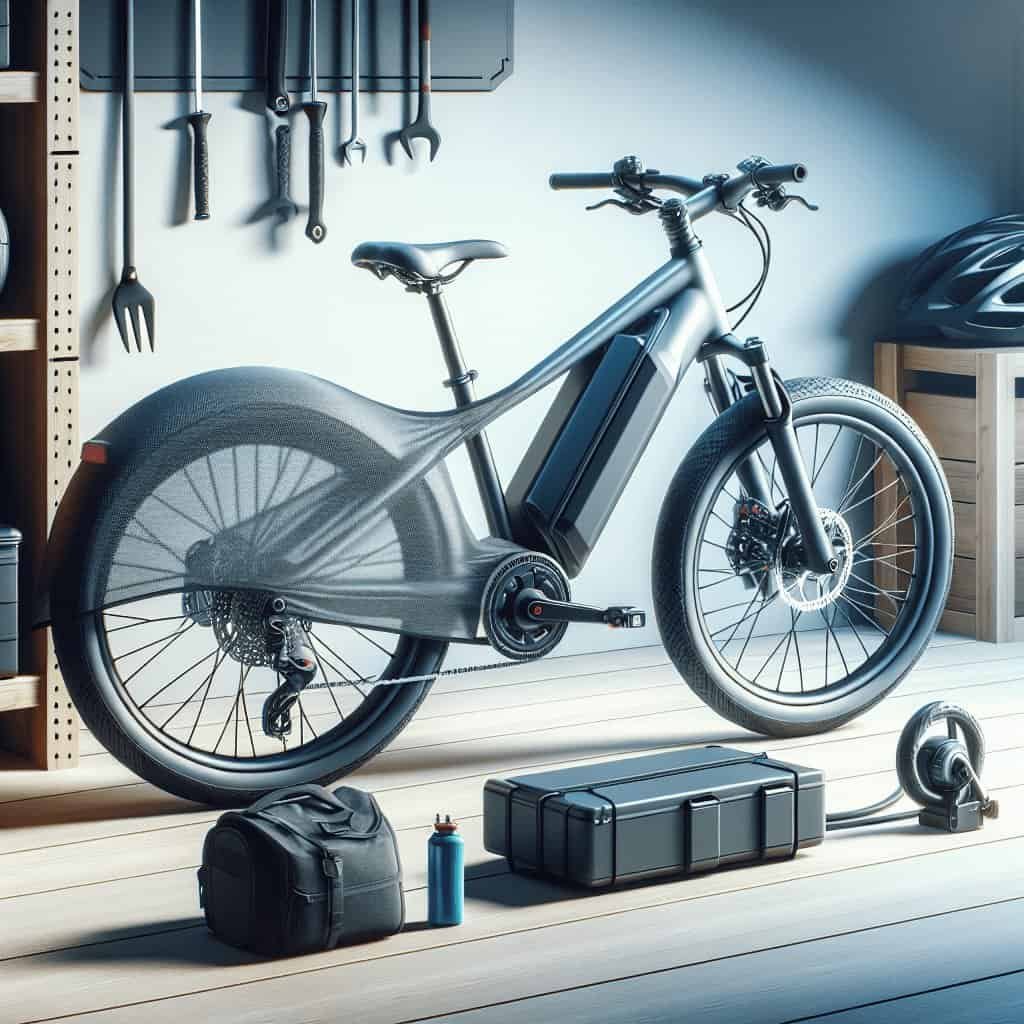If you own an electric bike and find yourself needing to store it for an extended period of time, you may be wondering how to keep it in the best condition possible. Whether it’s due to travel, the change of seasons, or any other reason, proper storage is essential to ensure the longevity and performance of your electric bike. In this article, we will explore some key tips and guidelines on how to properly store your electric bike, protecting it from potential damage and ensuring it’s ready to ride when you’re ready to hit the road again.
Cleaning and Maintenance
Cleaning the bike
To properly store your electric bike for an extended period, the first step is to ensure that it is clean. Start by using a gentle cleaning solution and a soft cloth or sponge to wipe down the entire bike, paying special attention to the frame, wheels, and other components. Make sure to remove any dirt, dust, or debris that may have accumulated during your rides.
Checking the tires
After cleaning the bike, it is crucial to check the tires for any signs of wear or damage. Inspect the tread for excessive wear, and ensure that there are no cuts or punctures that may cause a flat tire. If you notice any issues, it is advisable to replace the tires before storing the bike.
Inspecting the chain and drivetrain
The chain and drivetrain are vital components of your electric bike, so it is important to give them some attention before storing the bike. Use a clean cloth to wipe away any dirt or grease from the chain, and check for any signs of rust or damage. Inspect the gears and derailleurs for proper alignment and smooth operation. If necessary, lubricate the chain and drivetrain to prevent rust and ensure optimum performance when you take your bike out of storage.
Applying lubricant to moving parts
Before storing your electric bike, it is crucial to apply lubricant to the moving parts to protect them and maintain their functionality. Focus on areas such as the chain, pedals, and hinges, and use a high-quality lubricant designed specifically for bikes. Apply a thin layer of lubricant to these parts and wipe away any excess to prevent accumulation of dirt or debris.
Checking and adjusting brakes
Properly functioning brakes are essential for your safety and the longevity of your electric bike. Take the time to inspect the brake pads and ensure that they have enough thickness for effective braking. Adjust the brake cables if needed and make sure the brakes engage smoothly. Any issues with the brakes should be addressed and repaired before storing the bike.
Battery Preparation
Fully charging the battery
One of the most important steps in storing your electric bike for an extended period is to fully charge the battery before doing so. This is important to ensure that the battery maintains its health during the storage period. Follow the manufacturer’s instructions on how to charge your bike’s battery, and allow it to reach its full capacity before proceeding with the storage process.
Removing the battery
To prolong the lifespan of your electric bike’s battery, it is recommended to remove it before storing the bike. This will help prevent any potential damage that could occur due to temperature changes or humidity. Before removing the battery, ensure that the bike is turned off and the battery is safely disconnected according to the manufacturer’s instructions.
Storing the battery
Once the battery is removed, it is crucial to store it properly to maintain its performance. Ideally, the battery should be stored in a cool and dry place, away from direct sunlight or extreme temperatures. It is also important to avoid storing the battery near any flammable materials or chemicals. Consider using a storage case specially designed for bike batteries to provide an extra layer of protection.
Avoiding extreme temperatures
Extreme temperatures, whether hot or cold, can have a negative impact on the performance and longevity of electric bike batteries. It is best to store the battery in an area where the temperature remains relatively stable, ideally between 50°F and 70°F (10°C and 21°C). Avoid storing the battery in freezing or excessively hot environments, as this can lead to irreversible damage.

Securing the Bike
Choosing a suitable storage location
When it comes to storing your electric bike, selecting a suitable location is essential. Ideally, you should store the bike in a dry and secure area, such as a garage or a shed. If an indoor storage option is not available, consider using a bike cover to protect the bike from the elements.
Using a bike cover
To protect your electric bike from dust, dirt, and potential damage, consider using a bike cover. Bike covers are designed to keep your bike clean and shielded from the elements when stored outdoors. Look for a cover that is waterproof and able to withstand UV rays to ensure maximum protection.
Locking the bike
Security should be a priority when storing your electric bike. Even if the bike is stored in a locked garage or shed, it is advisable to use a high-quality bike lock to prevent theft. Invest in a sturdy lock that is resistant to cutting or picking, and secure the bike to a fixed and immovable object, such as a bike rack or wall mount.
Protecting against theft
In addition to locking the bike, there are other measures you can take to protect your electric bike from theft. Consider installing a GPS tracker on your bike, which can help locate it in case of theft. You can also register your bike with local authorities or online platforms dedicated to bike registration. Taking these precautions can give you peace of mind while your bike is in storage.
Tire and Tube Protection
Inflating the tires properly
Properly inflated tires not only ensure a smoother ride but also help prevent damage during storage. Before storing your electric bike, make sure the tires are inflated to the recommended pressure. This will help maintain their shape and prevent flat spots from forming. Consult your bike’s manual or the sidewalls of the tires for the recommended tire pressure.
Removing and storing tires
If you plan to store your electric bike for an extended period, consider removing the tires to prevent unnecessary wear and damage. This step is especially important if you’re storing the bike in a location with extreme temperatures or high humidity. Once the tires are removed, store them in a cool and dry place, away from direct sunlight.
Protecting the tubes
The inner tubes of your electric bike’s tires are susceptible to damage if not properly protected during storage. Before removing the tires, consider applying a thin layer of talcum powder or using tube protectors. These measures can help prevent the tubes from sticking to each other and minimize the risk of damage caused by friction or humidity.
Preventing flat spots
When storing your electric bike for a long period, it is important to prevent flat spots from forming on the tires. Flat spots can occur when the weight of the bike presses down on the same area of the tires for an extended period. To avoid this, periodically rotate the tires or consider using a bike stand to elevate the bike and reduce pressure on the tires.

Frame and Component Protection
Inspecting and repairing the frame
Before storing your electric bike, carefully inspect the frame for any signs of damage, such as cracks or dents. In the case of minor scratches or blemishes, consider applying touch-up paint to prevent rust from forming. If you notice any major structural issues, it is advisable to consult a professional for repairs before storing the bike.
Protecting vulnerable components
Certain components of your electric bike may be more susceptible to damage during storage. For example, the display unit or handlebar grips can be easily scratched or damaged. Consider using protective covers or wraps to safeguard these vulnerable components. In addition, cover the seat or remove it entirely to prevent any damage or wear during storage.
Using frame protectors
To further protect the frame of your electric bike from scratches or damage, consider using frame protectors. These are adhesive strips or patches that can be applied to areas where cables or other parts come into contact with the frame. Frame protectors are particularly useful in preventing cable rub or potential damage caused by transport or storage.
Applying rust preventive solutions
Electric bikes are subject to the same rusting risks as traditional bicycles. To protect your electric bike’s frame and components from rust, consider applying a rust preventive solution. There are many products available that can be sprayed or applied to vulnerable areas to create a protective barrier against moisture and corrosion.
Storage Duration Considerations
Short-term storage
If you plan to store your electric bike for a short period, such as a few weeks or a month, some basic precautions will suffice. Ensure the bike is clean, the tires are properly inflated, and the battery is charged to about 50-70% of its capacity. Choose a secure storage location, lock the bike, and periodically revisit the bike to check its condition.
Long-term storage
For longer storage periods, such as several months or over the winter season, it is important to take additional precautions. In addition to the steps mentioned earlier, fully charge the battery and remove it from the bike. Consider storing the battery separately in ideal conditions to prevent any potential damage. Properly clean and lubricate the bike, and follow all other steps outlined in this article for optimal storage.
Revisiting the bike periodically
Regardless of the storage duration, it is recommended to revisit your electric bike periodically. Check the tires for proper inflation and any signs of damage. Inspect the battery to ensure it is maintaining its charge and not experiencing any issues. Wipe down the bike to remove any dust or debris that may have accumulated. These periodic check-ups will help ensure that your electric bike remains in good condition while in storage.
Maintaining essential features
During the storage period, it is important to maintain the essential features of your electric bike. This includes keeping the battery charged, even if it is not in use. Lithium-ion batteries tend to perform better with some charge, so periodically charge the battery to about 50% capacity and then disconnect it to avoid overcharging. Additionally, consider turning on the bike and activating the display or controls to keep the electronic components active and prevent any potential issues from prolonged inactivity.

Maintenance Schedule
Creating a maintenance checklist
To keep your electric bike in good condition, it is advisable to create a maintenance checklist. This checklist should include all the necessary tasks and intervals at which they should be performed. It can include items such as checking tire pressure, inspecting the brakes, and lubricating the chain. By following a maintenance schedule, you can ensure that your electric bike remains in optimal condition.
Following recommended procedures
When performing maintenance tasks on your electric bike, it is important to follow the manufacturer’s recommended procedures. Refer to the bike’s manual for specific instructions on tasks such as adjusting the brakes, cleaning the drivetrain, or replacing components. Following these procedures will help ensure that the maintenance is performed correctly and that the bike is properly cared for.
Servicing the bike before use
Before taking your electric bike out of storage and using it again, it is recommended to service the bike. This can involve tasks such as cleaning, lubricating, and inspecting all components. Pay special attention to safety-related parts, such as the brakes and lights, to ensure they are functioning properly. By servicing the bike before use, you can ride with confidence and prevent any potential issues that may have arisen during storage.
Safety Precautions
Disconnecting the battery
When storing your electric bike, it is essential to disconnect the battery to prevent accidental discharge or damage. Follow the manufacturer’s instructions for disconnecting the battery safely. This will help avoid any potential electrical issues or hazards during storage.
Storing the bike in a well-ventilated area
To ensure the safety of your electric bike during storage, it is important to choose a well-ventilated area. Electric bike batteries can generate heat, and proper ventilation will help dissipate heat and prevent any buildup that could lead to damage or potential hazards. Avoid storing the bike in enclosed or tight spaces where heat can accumulate.
Avoiding flammable materials
When storing your electric bike, it is crucial to keep it away from flammable materials. This includes not only the bike itself but also the battery and any cleaning or maintenance products you may be using. Keep the bike and its components away from open flames, sparks, or other potential ignition sources to minimize the risk of fire or combustion.
Using proper lifting techniques
Electric bikes can be heavy and awkward to lift, especially if you need to remove the battery or perform maintenance tasks. To avoid strains or injuries, it is important to use proper lifting techniques. Bend your knees and use your legs, rather than your back, to lift the bike. If necessary, consider using a bike work stand or asking for assistance to ensure safe and proper lifting.

Winter Storage
Preparing the bike for winter
Winter storage requires special attention to protect your electric bike from the cold and moisture. Before storing the bike for the winter season, thoroughly clean and dry it to remove any dirt or moisture that may have accumulated. Follow all the steps outlined in this article, including removing the battery and storing it separately, as well as checking and lubricating all components.
Storing the bike indoors
Whenever possible, it is recommended to store your electric bike indoors during the winter months. Extreme cold temperatures can negatively impact the battery and other components, leading to decreased performance or potential damage. Find a cool and dry area, such as a basement or a garage, to protect the bike from freezing temperatures, excessive moisture, and other winter-related issues.
Keeping the bike dry
Moisture is one of the biggest enemies of electric bikes, particularly during winter storage. Any accumulated moisture can lead to rust, corrosion, or damage to electrical components. Make sure the bike is completely dry before storing it, and consider using moisture-absorbing products or placing a dehumidifier in the storage area to maintain low humidity levels.
Checking for corrosion
After the winter storage period, it is important to thoroughly inspect your electric bike for any signs of corrosion. Check all metal components, such as the frame, handlebars, and spokes, for any signs of rust or damage. If you notice any areas of concern, address them promptly to prevent further corrosion. Clean and lubricate the affected parts, and consult a professional if extensive damage is present.
Expert Advice
Consulting the bike manufacturer’s manual
When it comes to storing your electric bike, it can be helpful to consult the bike manufacturer’s manual for specific guidelines and recommendations. The manual will provide valuable information on battery maintenance, storage procedures, and best practices for keeping your bike in optimal condition. Take the time to familiarize yourself with the manual and follow its guidance to ensure proper storage.
Seeking guidance from a professional
If you have any doubts or concerns about storing your electric bike, it is always a good idea to seek guidance from a professional. Electric bike retailers, mechanics, or technicians have expertise in handling and maintaining electric bikes. They can provide personalized advice based on your specific bike model and storage conditions, ensuring that you have all the information you need for proper storage.
Researching online resources
The internet is a vast source of information, and there are numerous online resources available to help you properly store your electric bike. Look for reputable websites, forums, or blogs that specialize in electric bikes and maintenance. You can find valuable tips, step-by-step guides, and even video tutorials that can assist you in storing your electric bike effectively.
Properly storing your electric bike for an extended period is essential to maintain its performance, longevity, and safety. By following the cleaning and maintenance steps, preparing the battery, securing the bike, protecting the tires and tubes, and taking necessary precautions, you can ensure that your electric bike remains in top condition during storage. Remember to periodically revisit the bike, follow a maintenance schedule, and consult experts when needed. With proper storage and care, your electric bike will be ready for your next adventure whenever you’re ready to ride again.


